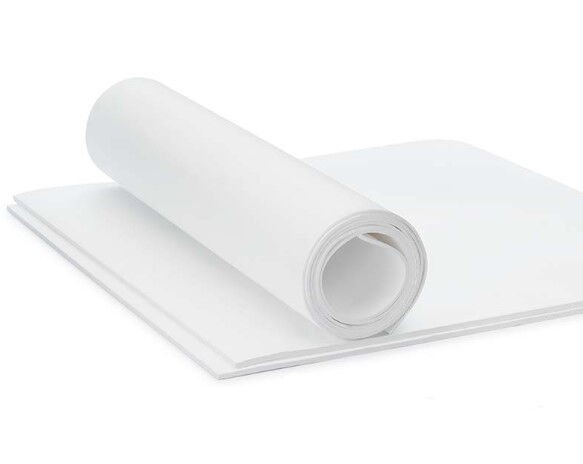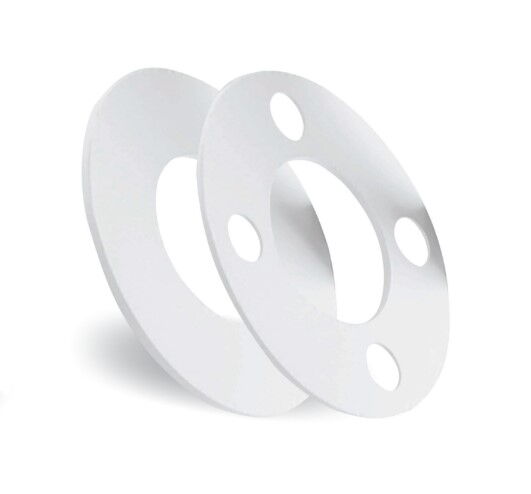Polytetrafluoroethylene (PTFE) is widely used in various sealing applications due to its excellent chemical stability and non-stick properties. However, when faced with challenges such as creep and cold flow, traditional PTFE gaskets also reveal their limitations. To address this shortcoming, Expanded PTFE gaskets has emerged as a solution. In this article, we will introduce the properties, manufacturing process, advantages, and extensive applications of Expanded PTFE gaskets across various industries.
Polytetrafluoroethylene (PTFE) is a high molecular weight compound formed by the polymerization of tetrafluoroethylene. It is often referred to as the "king of plastics," a title it truly deserves. PTFE boasts excellent chemical stability, with the ability to withstand the corrosion of almost all chemical substances, except for molten metallic sodium and liquid fluorine, and it remains unchanged even in aqua regia. This material also has outstanding high and low-temperature resistance, maintaining stability over a wide temperature range. Additionally, it features lubrication and non-stick properties, as well as good anti-aging characteristics, all of which contribute to its excellent sealing performance.
However, PTFE is not without its flaws. One of its drawbacks is the occurrence of creep and cold flow. In simple terms, the material will deform under prolonged stress. To solve this problem, technicians have developed a special process. They mix PTFE resin and lubricants in a certain proportion, and then go through a series of procedures including drying, stretching, and heat setting to produce Expanded PTFE, also known as soft PTFE. This material not only retains the excellent properties of PTFE but also offers better flexibility, compressive resilience, and resistance to creep and cold flow, enabling long-term safe use in extreme environments.
Let's delve into the manufacturing process of Expanded PTFE gaskets. This process is not only complex but also requires precise control of each step to ensure the high quality and superior performance of the final product.

Mixing: The first step in the manufacturing process is to mix PTFE resin with a lubricant in a specific mass ratio. The dispersion resin used here has good fiber-forming properties and low inter-particle cohesion. This means that when the molecular chains are subjected to a small amount of shear force, they will align along the particle's long axis, forming linear crystals. The role of the lubricant is to increase the adhesion between particles, reduce the friction between resin particles and between the resin and the container, thereby improving the processability. Common lubricants include petroleum ether, toluene, acetone, kerosene, and paraffin wax.
Pre-formation: The mixed material is then pressed into a blank with the same shape as the extrusion machine's mold cavity. This step is to make the material easier to form in subsequent processing.
Extrusion: The blank is placed into the mold cavity of the extrusion machine for extrusion, resulting in a rod. This step is similar to squeezing dough through a mold to form noodles of a specific shape, only here the "dough" is the PTFE mixture and the "noodles" are the rods.
Calendering: The rod is then calendered with rollers to produce a tape of the desired width and thickness. This is akin to rolling a thick noodle into a thin sheet with a rolling pin, making it more suitable for subsequent processing.
Drying: The tape is heated to remove the lubricant, resulting in a PTFE base film. This step is to remove the lubricant from the material, bringing it to a state suitable for further processing.

Expansion: The PTFE base film is quickly stretched, with the stretching temperature controlled between the glass transition temperature (115°C) and the melting point (327°C) of PTFE. This is because polymer chains only have sufficient activity to be stretched and straightened, and to move relative to each other, when the temperature is above the glass transition temperature. If the temperature exceeds the melting point, the PTFE particles will melt into a dense whole, destroying the original folded fiber structure of the particles, making it difficult to stretch.
Setting: The expanded PTFE base film is placed on a template and then put into a mold, where it is integrated through heating and pressurization. The setting process involves heating at a certain rate to above the melting point (327°C), followed by holding at a certain temperature and pressure for a period of time to fix the mesh structure formed by stretching. This process must be carried out under a certain stress; otherwise, the fibers will contract during the heat treatment.
After these two complex stages, the final product is the Expanded PTFE gasket. This gasket contains no adhesives or additives, has excellent flexibility and compressive resilience, and retains strong chemical corrosion resistance.
Having explored the manufacturing process of Expanded PTFE gaskets, let's now delve into their unique advantages. These advantages not only set them apart from other sealing materials but also enable them to demonstrate superior performance in various complex working conditions, making them stand out in the field of sealing.
Expanded PTFE gaskets are easy to cut and can be shaped into gaskets of any form through mechanical stamping or manual cutting. This flexibility allows them to adapt to a variety of complex working conditions, facilitating installation and use, thereby simplifying the work process. Thanks to their unique conformability, they can achieve good sealing effects on rough or damaged flange surfaces without the need for excessive pressure during installation.
Except for a few chemicals such as molten alkali metals, free fluorine, and trivalent nuclear substances, Expanded PTFE gaskets do not react with any chemical substances. This means that within the temperature range (315°C) they can withstand, they can be applied in almost all sealing scenarios. This significantly reduces the variety and quantity of sealing components, lowering the procurement and inventory costs for businesses.
Due to the unique high-density fiber structure of Expanded PTFE material, it has strong anti-creep characteristics. Moreover, since it contains no adhesives or additives, its mechanical properties are very stable. This allows it to maintain good sealing performance over long-term use, reducing the risk of leaks caused by material aging or deformation.
Expanded PTFE gaskets can withstand long-term use in high-temperature environments without decomposing, deforming, or cracking. This characteristic enables them to maintain stable sealing performance even in high-temperature conditions, ensuring the safe operation of equipment.
Expanded PTFE material is non-toxic and odorless, and it does not produce any harmful gases or substances, posing no harm to humans or the environment. This makes it widely applicable in industries such as food and pharmaceuticals, where strict material safety requirements are in place.
Due to their excellent properties, Expanded PTFE gaskets are widely used in various industrial fields, with the main areas being:
Chemical Industry: In chemical production, strong acids, strong bases, and organic solvents are frequently encountered. Expanded PTFE gaskets have strong chemical corrosion resistance, effectively preventing the leakage of corrosive media and ensuring the safe operation of equipment. They are suitable for sealing applications in reactors, pipeline connections, and valves.
Petroleum Industry: Petroleum extraction and refining equipment need to withstand high temperatures, high pressures, and corrosive media. Expanded PTFE gaskets are ideal sealing materials due to their high-temperature resistance, corrosion resistance, and good mechanical properties. They can be used for sealing in oil wells, pipeline connections, and valves in refining equipment, ensuring the safe and efficient production of petroleum.
Pharmaceutical Industry: The pharmaceutical industry has high requirements for material safety and cleanliness. Expanded PTFE gaskets are non-toxic, odorless, non-adhesive, and chemically resistant, meeting industry standards. They can be used for sealing in pharmaceutical equipment such as reactors, pipelines, and valves, ensuring the quality and safety of pharmaceutical production.
Power Industry: Power equipment, such as power generation units and transformers, requires good sealing. Expanded PTFE gaskets have high-temperature and high-pressure resistance, as well as good insulation properties, making them suitable for sealing in power generation unit cooling systems and transformers, ensuring the stable operation of equipment.
Food Industry: Sealing materials for food processing equipment must comply with food safety standards. Expanded PTFE gaskets are non-toxic, odorless, and non-adhesive, making them suitable for sealing in food processing equipment such as pipelines, valves, and reactors, ensuring the hygiene and safety of food processing.
Expanded PTFE gaskets, with their superior properties, play a significant role in various industrial fields. They not only solve the problems of creep and cold flow in traditional PTFE materials but also enhance the material's flexibility, compressive resilience, and creep resistance through special processes. These gaskets are easy to process and install, have superior chemical corrosion resistance, excellent mechanical properties, and good thermal stability, while also being environmentally friendly and harmless. Whether in the chemical, petroleum, pharmaceutical, power, or food industries, they provide reliable sealing solutions, ensuring the safe operation of equipment and the efficient progress of production. With the continuous advancement of technology and the expansion of application fields, Expanded PTFE gaskets are bound to play an even greater role in the future, safeguarding industrial development.
